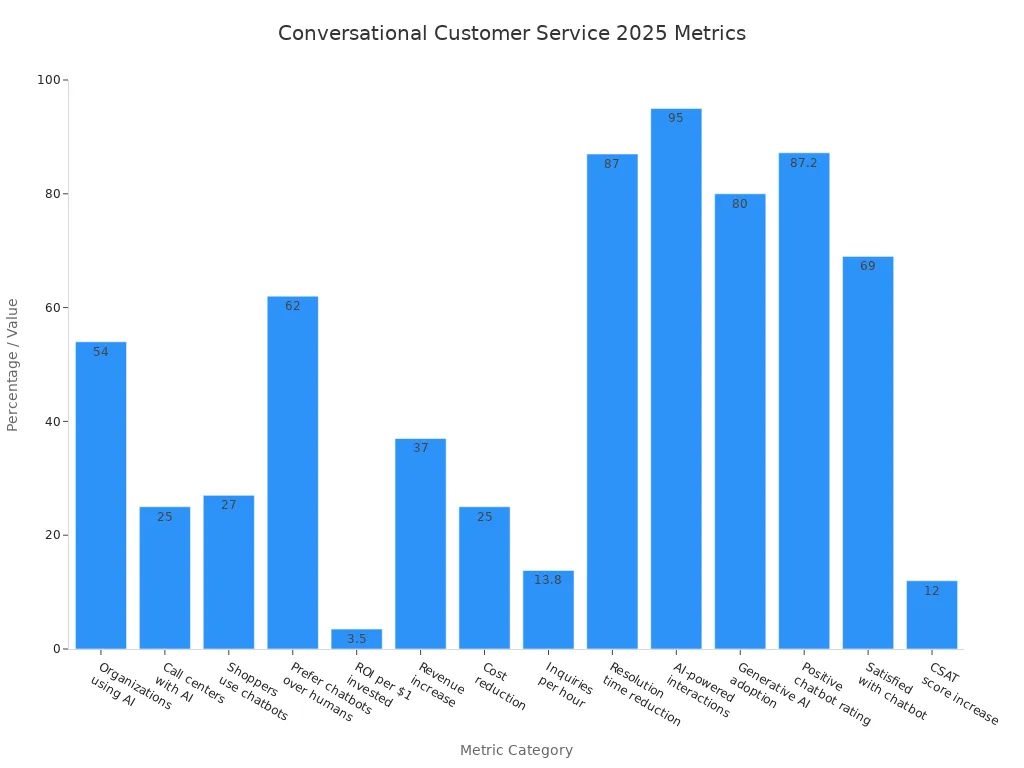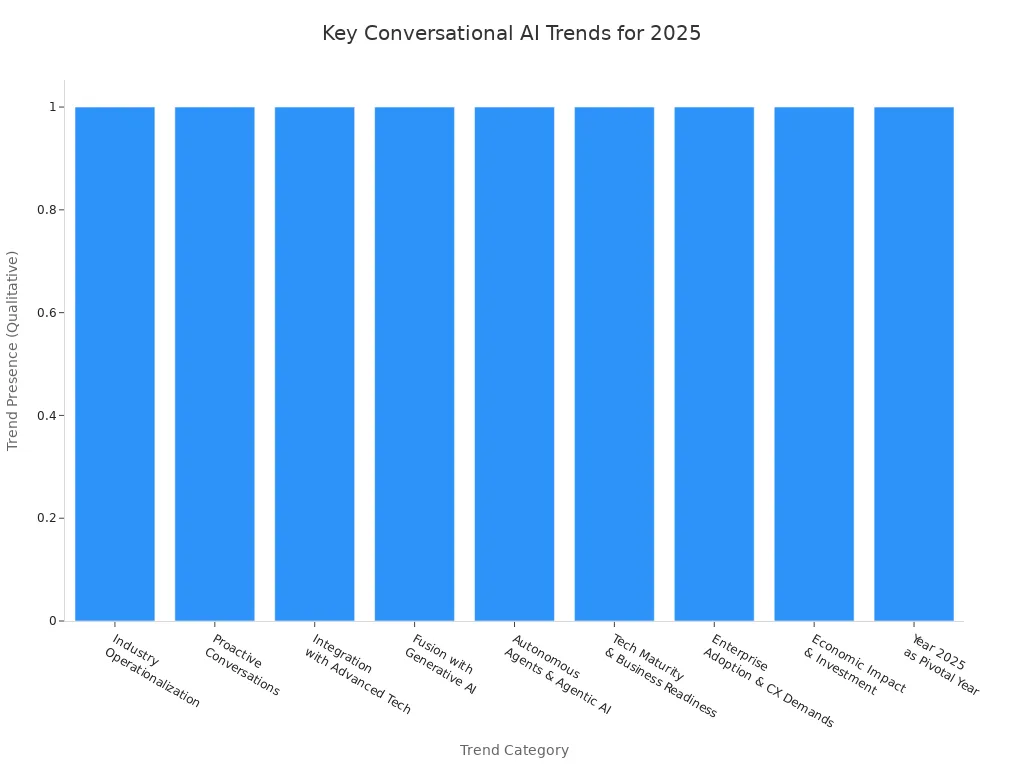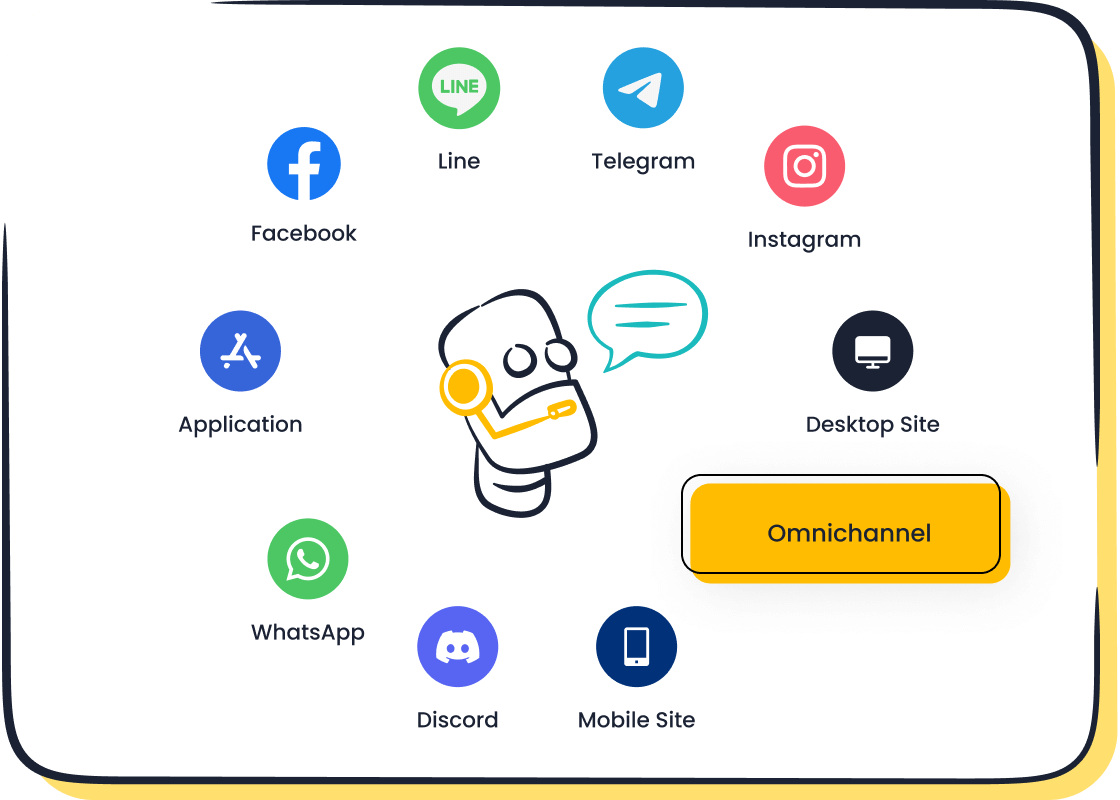Latest Trends Shaping Conversational Customer Service in 2025

Conversational customer service in 2025 has entered a new era. Companies now rely on conversational AI and automation to transform customer experience and drive business results. Sobot leads this change with Sobot AI, enabling seamless interactions across channels. Recent data shows 95% of customer interactions will use ai customer service, and 80% of organizations are adopting generative conversational ai.

OPPO’s integration of Sobot call center solutions demonstrates how ai in customer service boosts satisfaction and efficiency, setting the pace for customer service trends worldwide.
Market Overview
Growth in Conversational Customer Service
The global market for conversational customer service platforms is expanding at an unprecedented pace. In 2023, the market reached a value of $22.34 billion. Projections indicate growth to $105.54 billion by 2031, with a compound annual growth rate of 21.42%. This surge reflects the increasing demand for ai customer service solutions that deliver real-time engagement and automate routine support tasks. Businesses in telecommunications, retail, and e-commerce have accelerated investments in these platforms. Retail and e-commerce sectors are expected to grow at a CAGR of 29.6%, driven by the need for efficient support and personalized customer experience.
Advancements in natural language processing and machine learning have transformed how companies interact with customers. AI customer service agents now provide human-like responses, reducing wait times and improving operational efficiency. The shift from single-channel support to omnichannel conversational AI platforms marks a major customer service trend. Customers expect seamless support across multiple channels. 71% want assistance on various platforms, and 62% feel frustrated when repeating issues. AI customer service addresses these challenges, enhancing brand loyalty and retention.
The market’s rapid conversational ai adoption signals a new era for customer experience, where automation and personalization drive satisfaction and business growth.
Adoption Across Industries
Conversational customer service platforms have gained traction across diverse industries. Telecommunications led the market in 2023, with 43% of professionals investing in generative AI and 53% recognizing its competitive advantage. Healthcare organizations deploy ai customer service to improve patient experience and reduce staff burnout. EliseAI, for example, handles 95% of patient inquiries, reducing hold times and speeding up processes for 89% of users. E-commerce and financial services also report significant benefits. Klarna’s AI assistant manages two-thirds of customer interactions, resulting in a 25% drop in repeat inquiries and a predicted $40 million profit improvement.
The following table highlights regional leaders in conversational customer service adoption:
| Region | Leading Countries/Areas |
|---|---|
| North America | United States, Canada |
| Europe | Germany, France, United Kingdom, Spain, Italy, Russia, Netherlands |
| Asia Pacific | China, Japan, South Korea, India, Australia, Singapore, Thailand, Vietnam |
| Latin America | Brazil, Mexico |
| Middle East & Africa | South Africa, Saudi Arabia, UAE |
Asia Pacific, especially Singapore, is experiencing the highest growth rate in ai customer service adoption. The region leverages chatbots and virtual assistants to enhance efficiency and customer experience. Europe’s growth is fueled by Industry 4.0 and IoT expansion, while North America benefits from supportive regulations. Industries such as retail, healthcare, and financial services continue to drive the expansion of conversational customer service, setting new standards for customer experience worldwide.
Conversational AI Trends

The landscape of conversational AI in 2025 reveals a dynamic shift in how businesses approach customer engagement. Companies now deploy advanced ai customer service solutions that go far beyond basic chatbots. These conversational ai trends shape the future of customer support, driving efficiency, personalization, and satisfaction across industries.

Autonomous AI Agents
Autonomous AI agents represent a breakthrough in ai customer service. Unlike traditional chatbots, these agents operate independently, managing complex workflows and making strategic decisions. Businesses leverage conversational ai to automate up to 65% of routine tasks, resulting in a 7.8% increase in productivity and a 6.7% rise in customer satisfaction. Persistent long-term memory integration allows these agents to remember user preferences and context, eliminating conversational amnesia and creating more personalized experiences.
Multi-agent systems coordinate specialized conversational virtual agents for different roles, improving workflow management and task execution. Hybrid reasoning models enable agents to switch between intuitive and logical problem-solving, enhancing accuracy and speed. Expanded toolsets and standardized interfaces empower agents to perform multi-step tasks such as web browsing, code execution, and database access without human intervention.
Autonomous AI agents now resolve up to 86% of customer questions with personalized answers, outperforming traditional chatbots in both resolution rates and satisfaction.
| Metric | Autonomous AI Agents Performance | Traditional Chatbots Performance |
|---|---|---|
| Customer Satisfaction | Up to 40% higher overall; IBM Watson: 75% higher | Lower satisfaction rates |
| Resolution Rates | Up to 50% higher; 90% companies report improvement | Lower resolution rates |
| Resolution Time | 30% faster overall; IBM Watson: 60% reduction | Slower response times |
| Customer Preference | 80% of customers prefer AI agents for personalization and context awareness | Less preferred due to rigid scripts |
| Personalized Responses | Can resolve up to 86% of questions with personalized answers | Lower personalized response capability |
In 2025, agentic AI systems interpret high-level goals, execute necessary steps, and proactively personalize support by remembering customer history and context. These advancements enable faster, more accurate, and empathetic customer interactions. AI agents assist human agents by suggesting responses, summarizing interactions, and triggering workflows, allowing humans to focus on complex, emotionally intelligent problem-solving. Businesses in retail, finance, and healthcare report significant improvements in operational efficiency and customer loyalty by adopting these conversational ai trends.
Emotional Intelligence
Emotional intelligence in conversational ai has become a critical differentiator for ai customer service. Modern conversational ai systems use natural language processing, sentiment analysis, and affective computing to decode complex emotional signals in real time. Tone detection and behavioral analytics help AI interpret user emotions such as frustration or excitement, tailoring responses empathetically.
- Convolutional Neural Networks (CNNs) analyze speech spectrograms and text embeddings to detect subtle emotional cues.
- Sentiment analysis uses advanced natural language processing to understand emotional tone, context, sarcasm, and a wide range of emotions.
- Combining CNNs and sentiment analysis enables conversational ai to recognize tone, frustration, and sarcasm, allowing empathetic and contextually appropriate responses.
Low-code and no-code platforms integrate these technologies, making it easier for businesses to build emotionally intelligent conversational virtual agents. Emotionally intelligent AI adapts dynamically to user emotions, improving satisfaction and fostering trust. For example, Accor Plus reported a 20% increase in customer satisfaction after implementing emotionally aware ai customer service solutions. These conversational ai trends empower companies to deliver support that feels human, even when managed by chatbots or virtual agents.
Emotionally intelligent conversational ai tools foster trust and collaboration, making customers feel valued and understood.
Contextual Understanding
Contextual understanding marks a significant leap in conversational ai trends for 2025. AI customer service systems now interpret linguistic, cultural, situational, and historical contexts, delivering more accurate and personalized responses. Techniques like retrieval augmented generation (RAG) and embeddings help AI retrieve relevant information, refining response relevance and personalization.
Contextual understanding allows conversational ai chat agents to recall previous customer interactions and provide relevant, personalized responses. ServQuik, for example, saw a 30% increase in customer satisfaction and a 20% reduction in query handling time by using AI agents with contextual awareness across multiple channels. This improvement directly enhances the quality and efficiency of customer interactions.
- Real-time insights enable conversational ai to suggest responses and recommend next steps based on conversation history.
- Sentiment analysis detects customer frustration, allowing agents to adjust tone and show empathy.
- Automated follow-ups free agents from routine tasks, focusing them on meaningful interactions.
- Hyper-personalization at scale makes customers feel understood and valued by tailoring recommendations and anticipating needs.
- Seamless channel transitions ensure customers do not repeat information, enhancing experience consistency.
- Faster resolution times occur as conversational ai and agents access full context, improving first-contact resolution rates.
- Empowered agents receive real-time support, improving efficiency and customer satisfaction.
Businesses now use conversational ai tools to provide 24/7 support, quick and accurate responses, and personalized interactions. These systems automate routine tasks, reduce operational costs, and improve customer experience. Conversational ai supports scalability, data-driven decision-making, and integration with existing systems, allowing companies to optimize workflows and focus human agents on complex issues.
Improved contextual understanding in conversational ai reduces misunderstandings and frustration, leading to smoother and more natural customer interactions.
The fusion of generative AI with conversational ai further enhances context understanding, dialogue management, and creativity. This combination supports complex interactions with improved precision, dynamic customization, and better routing between AI and humans. As conversational ai trends continue to evolve, companies must invest in advanced ai tools and chatbot solutions to stay competitive and meet rising customer expectations.
For more on the impact of conversational AI in business, see Gartner’s AI Customer Service Insights.
Omnichannel and Multimodal Support

Seamless Channel Integration
Businesses today face many challenges when integrating multiple customer service channels. Support teams often struggle to manage several customers at once, which can lead to overload and lower performance. Escalating issues becomes difficult, causing longer wait times and unresolved queries. Poor complaint handling may turn loyal customers into detractors. Employee burnout and high turnover increase training costs and reduce service quality. Choosing the right support channels is critical, as outdated or unresponsive channels can result in missed opportunities and dissatisfied customers.
| Challenge | Explanation |
|---|---|
| Lack of integration | Fragmented customer data and poor context for agents |
| Inconsistent customer experiences | Variations in service quality across channels |
| Increased complexity | More resources, technology, and training required |
| Higher training and staffing costs | More channels mean higher expenses |
| Difficulty prioritizing channels | Challenging to manage and prioritize interactions without integrated systems |
| Increased risk of data breaches | Multiple channels increase vulnerabilities |
| Technical challenges | Connectivity problems and software bugs can disrupt service |
| Customer confusion | Uncertainty about which channel to use |
| Higher implementation costs | Significant investment in technology and resources |
Omnichannel support addresses these issues by syncing interactions across all channels. Customers no longer need to repeat information, which leads to higher satisfaction and loyalty. Companies with strong omnichannel engagement retain up to 89% of customers, compared to only 33% for those with weak engagement. Real-time engagement across chat, social media, and email drives conversions and revenue growth. Personalized interactions become possible by tracking customer data across touchpoints, allowing tailored solutions and engagement. Seamless channel transitions ensure customers do not have to repeat concerns, improving the overall customer experience and speeding up resolution.
Companies that synchronize data across channels reduce friction, prevent customers from repeating information, and improve satisfaction. This approach leads to increased retention, revenue growth, and brand loyalty.
Sobot Chatbot Capabilities

Sobot’s chatbots set a new standard for omnichannel customer experience. The chatbot integrates with WhatsApp, SMS, social media, e-commerce, and CRM platforms, providing seamless communication across every touchpoint. Sobot supports over 50 languages, enabling businesses to engage customers worldwide and handle cultural nuances with ease. Real-time sentiment analysis, combined with conversational AI, allows the chatbot to respond dynamically and emotionally to customer needs.
Sobot’s chatbot handles large volumes of interactions, maintaining high performance and quality sentiment analysis. Flexible pricing starts at $30 per month, making it accessible for small and medium businesses while scaling to meet enterprise needs. Real-time analytics and customizable dashboards help businesses monitor sentiment trends and customer satisfaction. Sobot’s chatbot experience stands out with proven results: OPPO achieved an 83% chatbot resolution rate, a 94% positive feedback rate, and a 57% increase in repurchase rate after implementing Sobot’s solutions (source).
Retail, e-commerce, and enterprise services benefit from Sobot’s AI chatbots. These chatbots automate routine queries, provide proactive support, and deliver personalized recommendations. Businesses report up to a 70% productivity increase and a 50% reduction in service costs. The chatbot’s omnichannel integration ensures customers receive consistent, personalized support, no matter which channel they choose. This approach enhances customer experience, drives loyalty, and supports business growth.
Sobot’s AI chatbots empower companies to deliver seamless, personalized, and efficient service across every channel, setting a benchmark for modern customer engagement.
Personalization and Predictive AI
Hyper-Personalization
Hyper-personalization has become a defining feature of conversational customer service in 2025. Companies now use ai tools and machine learning to analyze large volumes of customer data, adapting interactions to each individual’s context, preferences, and intent. This approach goes beyond basic personalization by delivering experiences that feel unique to every customer.
- AI tools like Five9’s GenAI Studio integrate data from CRMs, ERPs, and customer data platforms, enabling highly personalized responses.
- Real-time analysis of customer interactions helps identify sentiment and trends, allowing businesses to adjust their approach instantly.
- Omnichannel engagement ensures that context is retained across voice, chat, email, social, and messaging channels, creating a seamless experience.
- Trust and governance frameworks for AI maintain ethical standards and protect customer data, which is essential for building trust in hyper-personalized services.
Retailers and service providers use recommendation engines to suggest products or content based on real-time behavior. Intelligent chatbots leverage customer data to provide tailored assistance, while dynamic pricing and geo-targeted promotions offer personalized deals. In-app personalization adjusts interfaces and recommendations to match user preferences. Loyalty programs use purchase history to deliver rewards and reengagement offers.
Hyper-personalization enhances customer experience, increases engagement, and improves retention. Companies that leverage ai tools and data integration can scale personalized service while maintaining consistency across all channels.
In banking and financial services, AI analyzes customer interaction data to create detailed profiles and deliver proactive recommendations. Streaming platforms like Netflix set a high bar by adapting content and visuals to individual tastes, raising customer expectations for all industries.
Predictive Support
Predictive support uses AI to anticipate customer needs before they become problems. By analyzing behavior patterns and historical data, ai tools can foresee potential issues and offer solutions proactively. This approach leads to higher satisfaction and loyalty, as customers receive help before they even ask.
Predictive analytics enable personalized responses and automated alerts, reducing response and resolution times. Automated inquiry handling ensures prompt replies and efficient routing, allowing human agents to focus on complex cases. AI-powered systems send notifications, offer recommendations, and allocate resources based on urgency.
- Predictive AI sends alerts and notifications when it detects potential problems, keeping customers informed.
- It offers support recommendations tailored to individual preferences and behaviors.
- Efficient resource allocation prioritizes urgent or high-impact cases, improving operational efficiency.
- Companies benefit from reduced response times, proactive assistance, and increased satisfaction.
Industry leaders in telecom, e-commerce, healthcare, and finance use predictive support to anticipate disruptions, product returns, patient needs, and fraud. SaaS providers offer proactive tutorials and live assistance, helping users get the most from their products. AI-powered customer support can reduce resolution times by up to 50%, as shown in recent studies (source).
Data-Driven Insights
Data-driven insights play a crucial role in optimizing customer service strategies. Companies collect and analyze data from every interaction, using these insights to improve service quality and meet evolving customer expectations.
Key types of valuable data-driven insights include:
- Customer interaction data: Call transcripts, chat logs, and emails reveal common inquiries, preferences, and sentiment.
- Performance metrics: Measures like first-call resolution, average handling time, and satisfaction scores help assess service quality.
- Feedback and surveys: Direct input from customers highlights pain points and areas for improvement.
- Predictive analytics: Historical data forecasts future behavior, enabling proactive support.
- Sentiment analysis: Real-time analysis of language and tone tailors responses to customer emotions.
- Trend identification: Detects emerging patterns in inquiries, allowing companies to adjust resources and processes.
Companies also use segmentation to group customers by behavior or preferences, delivering more relevant experiences. Behavioral analytics identify friction points in the customer journey, helping reduce drop-offs and improve onboarding. Centralized feedback frameworks connect customer input directly to decision-making, enabling faster improvements.
By leveraging ai tools and integrating data from multiple sources, businesses create comprehensive profiles, resolve issues quickly, and deliver service that exceeds customer expectations.
A strong KPI framework tracks metrics like CSAT, NPS, and retention rates, guiding strategy and measuring success. Companies like Art.com have improved prioritization and customer experience by moving from scattered feedback to centralized analytics systems.
Multilingual and Global Reach
Sobot Chatbot Multilingual Support
Global businesses need to connect with customers in their preferred language. Sobot’s chatbot platform addresses this demand by offering robust multilingual support. The chatbot leverages advanced AI to interact with users in over 50 languages, reflecting the industry’s move toward supporting up to 135 languages with high accuracy. This capability allows companies to engage customers from different regions without language barriers. The chatbot provides 24/7 availability, ensuring that users receive instant and personalized support at any time. Businesses benefit from automated responses to routine inquiries, which increases operational efficiency and customer satisfaction. By using chatbots with multilingual features, organizations can scale their customer engagement and reach new markets with ease. The chatbot’s ability to understand and respond in multiple languages leads to higher conversion rates and improved loyalty among global customers.
Multilingual chatbots help companies deliver consistent, high-quality service to a diverse audience, building trust and expanding their global footprint.
Expanding Accessibility
Accessibility remains a core principle in conversational customer service. Sobot’s chatbot platform incorporates best practices to ensure that all users, including those with disabilities, can interact easily. Companies should:
- Provide 24/7 customer service through familiar digital channels, allowing users to communicate whenever they need help.
- Design chatbots compatible with screen readers, making the chatbot accessible for visually impaired users.
- Use clear labels for buttons and components, so screen readers can interpret the chatbot interface accurately.
- Clearly communicate the start and finish of each process, helping users know what to expect.
- Avoid unnecessary icons that may confuse screen readers.
- Configure emojis so they are read as text, and keep emoji selectors accessible until expanded.
- Differentiate messages from the user and the chatbot, so screen readers can identify the speaker.
- Follow legal requirements for accessibility, such as Brazil’s Decree No. 11,034 and Argentina’s Law No. 26,653, to ensure equal access for all.
These practices ensure that chatbots provide inclusive, user-friendly experiences for everyone. By prioritizing accessibility, companies not only comply with regulations but also demonstrate a commitment to serving all customers equally.
Human-AI Collaboration
Agent Assistance
Human agents now work alongside advanced ai-powered agent assistance tools, transforming the way customer service teams operate. These tools do more than answer questions—they execute tasks, search knowledge bases, and even trigger human intervention when needed. Companies see task times drop from hours to minutes or seconds. AI agents turn raw data into actionable insights, helping agents make faster and smarter decisions. For example, in insurance, AI automates claim processing, while in banking, it ensures precise answers to customer inquiries.
Key benefits of ai-powered agent assistance include:
- Real-time guidance: AI suggests next steps, troubleshooting tips, or product information during live interactions.
- Continuous learning: AI improves recommendations by learning from past conversations.
- Faster responses: Agents get instant access to information, reducing wait times.
- Higher accuracy: Data-driven suggestions ensure consistent, high-quality answers.
- Improved productivity: Routine tasks like information retrieval become automated, letting agents focus on complex issues.
- Enhanced customer satisfaction: Quick, accurate responses build loyalty.
- Shorter training time: New agents receive AI guidance, speeding up onboarding.
| Industry Example | Application |
|---|---|
| Customer Support | AI analyzes conversations and suggests solutions in real time. |
| Technical Support | Guides agents through troubleshooting with relevant resources. |
| Sales Support | Detects buying signals and suggests upsell opportunities. |
| Healthcare | Provides access to patient info and scheduling for accurate support. |
| Financial Services | Offers guidance on account management and compliance. |
AI-powered support tools help agents deliver better service, reduce errors, and keep customers happy.
Balancing Automation
Companies must find the right balance between automation and the human touch. AI handles simple queries, FAQs, and data collection, freeing agents to focus on complex or emotional issues. Customers expect fast responses—71% want answers within five minutes, and 83% value personalized service. However, 80-85% still prefer human interaction for sensitive matters.
Effective strategies for balancing automation include:
- Automate routine tasks and use AI to assist agents in real time.
- Train agents to work with AI systems.
- Set clear escalation paths for smooth handoffs between AI and humans.
- Monitor interactions to track satisfaction and adjust strategies.
- Prioritize customer channel preferences.
- Use hybrid models to combine efficiency with empathy.
A hybrid approach, where AI and humans collaborate, reduces complaints and increases satisfaction. Companies like Amazon resolve up to 70% of inquiries with AI, while brands known for high-touch service, such as Zappos, excel by letting humans handle complex cases. Multichannel engagement, tailored to customer preferences, boosts loyalty and operational scalability. Training and monitoring ensure that both AI and agents deliver consistent, high-quality service.
Security and Trust
Data Privacy
Protecting customer data stands as a top priority for conversational customer service platforms in 2025. Companies must address growing concerns about privacy and security as AI-powered systems handle more sensitive information. The latest security protocols focus on robust encryption, strict access controls, and continuous monitoring. The following table highlights key measures:
| Security Aspect | Key Protocols and Measures | Priority/Focus |
|---|---|---|
| Data Encryption | AES-256 for data at rest, TLS for data in transit, field-level encryption for sensitive fields | Critical to protect stored and transmitted data |
| API Security Controls | API key management, automated key rotation, RBAC, MFA | Essential to prevent unauthorized access |
| Security Testing | Daily vulnerability scans, monthly penetration tests, quarterly threat modeling, annual audits | Regular testing to mitigate vulnerabilities |
| Privacy Protection | Transparent consent, DPIAs, strict data retention policies | Critical for customer trust and compliance |
| Continuous Monitoring | Real-time threat detection, incident response planning | Ongoing vigilance against threats |
| Staff Training | Role-based AI security training, ethical decision-making education | Reduces human error |
| Ethical AI Guidelines | Bias reduction, fairness-aware algorithms, regular bias audits, human oversight | Builds trust and strengthens security |
| Compliance | Adherence to GDPR, CCPA, HIPAA, SOC 2 | Mandatory for legal and ethical operation |
"Decade-old features are providing unexpected attack surface to GenAI application. It is important for developers and application designers to consider the context in which they insert LLM output, as the output is untrusted and could contain arbitrary data." — Johann Rehberger, Security Researcher
A recent incident in 2023 showed the risks when Samsung engineers accidentally shared proprietary code through ChatGPT, exposing sensitive data. This event highlights the need for strict AI usage guidelines and security controls.
Compliance
Meeting global data privacy regulations is essential for building trust and meeting customer expectations. Leading conversational AI providers embed privacy-by-design principles into their platforms. They obtain explicit user consent, maintain transparency with clear data usage policies, and restrict third-party access to sensitive information. Providers conduct regular audits, enforce robust encryption, and empower users to control their data. Hosting infrastructure often aligns with regional requirements, such as processing European data within the EU.
Providers also address risks unique to large language models by setting guardrails against prompt injection attacks and performing rigorous testing. Regular vulnerability scans, comprehensive logging, and incident response plans ensure ongoing compliance. Adhering to regulations like GDPR, CCPA, HIPAA, and SOC 2 remains mandatory for legal operation and ethical AI use. These practices help companies meet rising customer expectations for privacy and security in every interaction.
Future of Conversational Customer Service
Self-Learning Systems
The future of conversational ai centers on self-learning systems that adapt and improve with every interaction. These advanced platforms use natural language understanding and affective computing to interpret emotions and deliver empathetic responses. AI chatbots such as "Ellie" and "ChatGPT" already demonstrate how personalized learning paths and instant feedback can reduce anxiety and boost motivation. Companies now integrate adaptive feedback mechanisms, which support both personalized learning and emotional engagement.
Key technologies shaping the future include:
- Large language models and neural networks for human-level understanding.
- Edge computing and quantum computing for faster, more secure processing.
- Brain-computer interfaces for deeper, more intuitive interactions.
- Ethical frameworks and data privacy measures to ensure trust and safety.
Sobot’s vision aligns with these trends by investing in generative AI and omnichannel solutions. The company focuses on blending AI with human expertise, ensuring that chatbots serve as complementary tools rather than replacements. Sobot’s approach emphasizes continuous innovation, emotional intelligence, and culturally responsive experiences, setting a strong foundation for the future of conversational ai.
ROI and Business Impact
Businesses see remarkable returns from investment in advanced conversational ai. Industry projections show that AI will handle up to 95% of customer interactions by 2025, transforming support into a faster, more efficient process (source). Sobot’s all-in-one contact center solutions help over 10,000 brands improve satisfaction, reduce costs, and increase efficiency.
| Metric / Case Study | Value / Impact |
|---|---|
| Average ROI for conversational AI | Approximately 300% |
| Highest reported ROI | Up to 500% |
| Customer support cost reduction (E-commerce) | 75% decrease |
| Sales increase (Financial services) | 25% increase |
| Customer satisfaction improvement (Healthcare) | 90% improvement |
The future of customer service depends on continuous investment in AI-driven tools. Companies that prioritize innovation and data-driven strategies will lead the market, achieving higher productivity and stronger customer loyalty. Sobot’s strategic direction supports this shift, empowering organizations to realize the full potential of conversational ai in the years ahead.
Conversational customer service continues to evolve, driven by AI, omnichannel integration, and hyper-personalization. Businesses achieve improved satisfaction by collecting data from every touchpoint, integrating AI with CRM systems, and training models with fresh information. Key recommendations include building feedback loops, ensuring privacy compliance, and balancing automation with human expertise. The table below highlights future trends shaping customer interactions:
| Trend | Description |
|---|---|
| Increased Adoption of AI | Autonomous agents enhance efficiency and free up human agents. |
| Omnichannel Experiences | Seamless integration across channels maintains context and consistency. |
| Personalization through Insights | Data analytics enable proactive, tailored support. |
| Focus on Employee Experience | AI tools reduce burnout and optimize workflows. |
The future promises deeper innovation, measurable strategic value, and ongoing transformation in customer service.
FAQ
What is conversational customer service?
Conversational customer service uses AI-powered chatbots and virtual agents to interact with customers in real time. Companies deliver support across multiple channels, including chat, voice, and social media. This approach improves efficiency, satisfaction, and personalization for every customer.
How does AI customer service improve business outcomes?
AI customer service automates routine tasks, reduces wait times, and provides instant responses. Businesses see higher productivity, lower costs, and increased customer loyalty. Sobot’s solutions help companies achieve up to 70% productivity gains and 50% cost reductions.
Why is omnichannel support important for customer experience?
Omnichannel support synchronizes customer interactions across chat, email, voice, and social media. Customers receive consistent service without repeating information. Companies with strong omnichannel engagement retain up to 89% of customers, driving loyalty and revenue growth (source).
How do chatbots personalize customer interactions?
Chatbots analyze customer data, preferences, and conversation history. They deliver tailored recommendations, proactive support, and dynamic responses. Sobot’s chatbot uses real-time sentiment analysis and multilingual capabilities to create personalized experiences for global audiences.
What security measures protect customer data in AI customer service?
Providers use encryption, access controls, and continuous monitoring to secure customer data. Sobot follows strict privacy protocols and complies with regulations like GDPR and CCPA. Regular audits and ethical AI guidelines ensure trust and safety in every interaction.
See Also
Best Cloud Contact Center Services Evaluated For 2024
Leading Ten Customer Feedback Software Solutions In 2024
Revealing The Best Cloud Contact Centers For 2025
How AI Service Agents Are Transforming Customer Support
Comprehensive Reviews Of Leading Contact Center Solutions 2024
